Categories
- Wire & Cable
- Multi-conductor & Signal Cable
- Battery Cable Assemblies
- Terminals and Connectors
- Electrical Parts
- Electrical Tools
- ID Products
- Wire Management
- Tape & Sealant
- Mounting Panels & Panel Blanks

Need Help?
Click HereGet a Business Account
Apply HereCable Pass Throughs
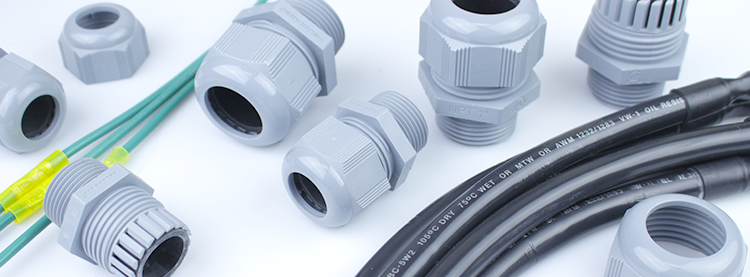
What are cable pass-throughs?
Cable pass throughs are any of a number of devices that are used to allow wires and cables to safely pass-through walls or other surfaces. They reduce or eliminate the damage that would otherwise be caused by rubbing or chafing. Cable pass-throughs can come in a variety of forms which is good as there is no one-size-fits-all approach to passing wires and cables through walls. For the most part, cable pass-throughs are simple to install meaning that a bit of time now can save you a major headache down the road. Without cable pass-throughs your wires and cables are subject to abrasion from the constant vibration and flex found in marine environments. Let us take a look at what makes these wire management materials so beneficial.
"cable pass-throughs are simple to install meaning that a bit of time now can save you a major headache down the road."
Where are these products implemented?
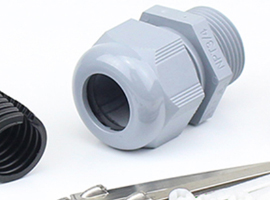
Cable pass throughs can create watertight connection points
Cable glands are implemented in applications where cables need to be passed through a wall or other surface and the point of entry needs to be waterproof. They can be installed and relied upon for long term durability. These products are useful in new installations as well as when replacing parts. Say that you have damaged cable glands or leaking cable glands, then these are the perfect solution for you. All you need is the proper battery cable. Now that we have covered where cable glands are implemented, let us look at what benefits they offer.
What benefits do cable pass throughs offer?
For starters, they offer protection from chafing and abrasion that would be caused by the edges of the surface they are passed through. Cable pass throughs come in a wide range of options giving you the freedom to pick the solution that works best for your specific needs. Not all products can make this claim. Additionally, when using cable clams or cable glands, you create watertight spots that can protect sensitive equipment from exposure to moisture and other elements. The be honest, cable pass-throughs are a necessity in a marine setting. Without them, you potentially leave your entire electrical system vulnerable. So now that we have covered what cable pass throughs are and the benefits that they offer, let’s talk about what types are available.



What types of cable pass-throughs are available?
In order to offer the largest number of solutions possible, we carry a range of cable pass-throughs. Some situations will call for cable glands, others may only need snap bushings. Below we will take a more in-depth look at each of these types and hopefully help you make a more informed decision.
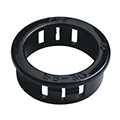
Snap bushings
Snap bushings reduce sharp edges and protect wires when passing through holes. They are designed to accommodate a variety of panel or box thicknesses. This way they can be used in a variety of settings or environments. How do they work? They "snap" into place easily and resist up to 35 pounds of pull. All you need to do is cut a hole to the correct size and pop one into place. They are literally that easy to install.
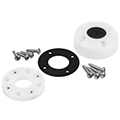
Cable clams
Cable clams allow for waterproof co-axial installation without removing connectors. This helps you to save the expense of removing and replacing connectors. They are made of three distinct pieces, that when combined create a superior seal. To use, you simply cut a hole to the correct dimensions and install it from both sides with the waterproof seal in the middle. Now as you pass your coaxial cable through, the seal forms around it.
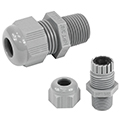
Cable glands
Cable gland connectors outperform traditional connectors. This is because the design consists of three parts that do not need to be separated before use. How does it work? The internal ratchet allows the cap to tighten without twisting the cable. It compresses, pushing the fingers together to form a liquid tight connection. This is further enhanced with a neoprene compression gland. These cable pass throughs are some of the most durable that we offer.
What is the difference between PG and NPT cable glands?
The main difference between PG and NPT glands is the depth of the thread. PG, which stands for Panzer-Gewinde is a Germanic thread type that has a smaller thread depth however, it has a wide flank angle (80°). When looking at NPT, which means National Pipe Thread, the threads are 1/16” deep but have a smaller flank angle (60°). The difference really boils down to preferences although it is fair to mention that PG glands are substantially larger in diameter than NPT glands. Other than these differences, they are designed and perform the exact same way.
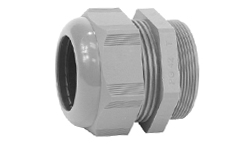
PG Cable Glands
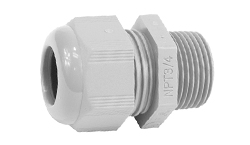
NPT Cable Glands
Why would I use cable pass-throughs?
Cable pass throughs are useful in just about any location where you need to pass a wire or series of wires or cables through a wall. They can be used on boats, in warehouses, shipping plants, and even in private garages. Basically, anywhere that you need to protect your electrical cable from potential chafing or abrasion. People often underestimate just how crucial these wire management materials really are.
What industries use these types of tools?
Industries all across the globe use cable pass throughs and for good reason. The high level of protection and long-term durability that they offer is hard to beat. This is why you will find cable pass throughs in use in the marine industry, aviation industry, communication industry, database industry, and many, many more. Choosing the correct cable pass throughs for your applications is not always an easy task. Contact a Pacer expert with any questions that you may have.
![]()


![]()
*This page was updated on 2/08/2023*


